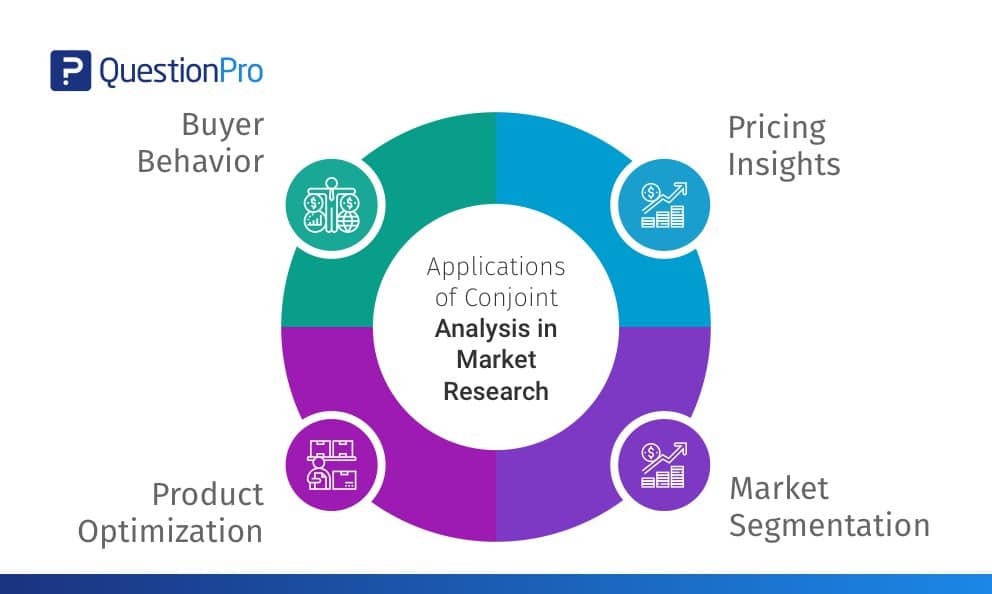 Reading Time: 3 minutes read
Reading Time: 3 minutes readConjoint analysis is a market research method used to determine the intrinsic value of a product or service. This method can help analyze how people value various aspects such as features, benefits, cost, etc.
The conjoint analysis method has been used by both academics and professional researchers for a long time now. It is widely used in retail, manufacturing, consumer goods, automobile, pharmaceutical, and service industries.
Why businesses should use conjoint analysis for market research?
The conjoint analysis finds out what combination of attributes is most effective on respondent choice. This gives a pointer to how people make decisions. A controlled set of potential products or services is shown to survey respondents. Based on their answers, it is analyzed on what basis do they make choices between them. Then it is determined which individual elements making up the product or service are valued most and least by the respondents. These elements are assigned a value and can be used to estimate the chances of success in the market.
LEARN ABOUT: Market Evaluation
The way an individual perceives value in a product depends on various factors – social, economic and demographics. So, how do you find out what importance an aspect of a product holds? Because all of them are interlinked. Changing one of them can have a significant effect on the other and overall product. This is achieved by conjoint analysis. It brings out the relationship between various factors and how they impact each other.
For market research, conjoint analysis software lets you design, distribute and create reports that you can share with other teams or departments. You can also create different reports by changing the filters based on demographics, question, device, system variable, etc.
LEARN ABOUT: Market research industry
Benefits of conjoint analysis
- Calculates mental trade-offs that respondents make when evaluating several attributes together
- Measures preferences at the individual level
- Brings hidden drivers to the surface
- Develop needs-based segmentation based on the interaction between attributes
QuestionPro helped Thales, a leading in-flight entertainment provider, to gain customer feedback at the point of experience for its airline customers. The survey solution helped Thales to become a part of critical decision chain, and airlines to improve their services and close the feedback loop.
Applications of conjoint analysis
Conjoint analysis can be used in scenarios where respondents need to arrange a list of attributes in their order of preference. Once respondents rank them, software for conjoint analysis can be used to find the utilities of different values of each attribute. This method is efficient because the survey need not be conducted for all possible combination of attributes. The utilities are determined from a subset of possible combinations of the attributes. The results help to add new features in a product or launch new products altogether. Some of the areas conjoint analysis can be used in are:
-
Buyer behavior
The conjoint analysis helps you understand the relative value given to various attributes of a product or service by a respondent. At times, they may find it difficult to decide whether the given factor is important for them or not. However, when given options, it makes it easier for them to attach relative significance to each factor. The conjoint analysis report explains which combination of attributes is valued more as compared to the other. This helps in understanding their preferences and how they make purchase decisions.
-
Pricing
As conjoint analysis survey presents a combination of various factors (with price as one of them) as options, it highlights at what price are consumers ready to purchase a certain package of product features. With the survey data available, the market researchers can decide what price works best for both themselves and the consumers.
-
Product optimization
Once the consumer preferences are available, businesses can have insights on which features are most and least favorite. Also, one can get ideas for new features and products, and evaluate the probability of their success in the new market.
-
Market segmentation
Market researchers can estimate the size of the market for each combination of attributes. Accordingly, they can devise a better strategy for launch and marketing, after having good visibility into consumer choices.
In case you are looking for an expert’s help on how to use survey data for conjoint analysis, let us know. We’d be happy to help you!




















